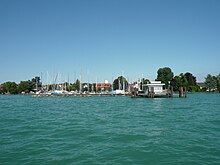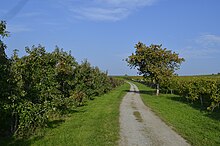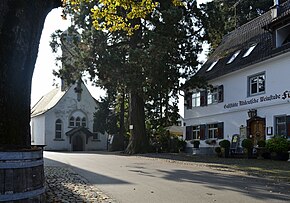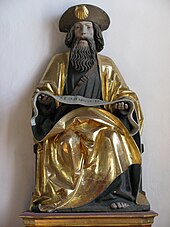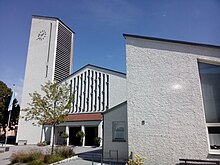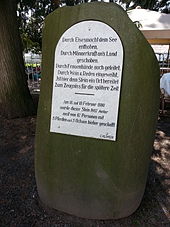Nun's horn
| coat of arms | Germany map | |
|---|---|---|

|
Coordinates: 47 ° 35 ' N , 9 ° 37' E |
|
| Basic data | ||
| State : | Bavaria | |
| Administrative region : | Swabia | |
| County : | Lindau (Lake Constance) | |
| Height : | 404 m above sea level NHN | |
| Area : | 1.97 km 2 | |
| Residents: | 1764 (Dec. 31, 2019) | |
| Population density : | 897 inhabitants per km 2 | |
| Postal code : | 88149 | |
| Area code : | 08382 | |
| License plate : | LI | |
| Community key : | 09 7 76 120 | |
| LOCODE : | DE NHR | |
| Address of the municipal administration: |
Conrad-Forster-Strasse 9 88149 Nonnenhorn |
|
| Website : | ||
| Mayor : | Rainer Krauss | |
| Location of the municipality of Nonnenhorn in the district of Lindau (Lake Constance) | ||
Nonnenhorn is a municipality on Lake Constance in the district of Lindau (Bodensee) in the Bavarian administrative district of Swabia . The climatic health resort and well-known wine town lies between Wasserburg and Kressbronn on the border with Baden-Württemberg .
geography
location
Nonnenhorn is located on the north bank (sunny side) of the Bavarian part of Lake Constance . In terms of area, it is the third smallest and at the same time most southwestern municipality in the Free State of Bavaria . In the west, Nonnenhorn borders on Baden-Württemberg . There is only the Nonnenhorn district . The length of the lakeshore is 3.8 km. The hinterland is characterized by Ice Age moraine hills ( drumlins ) with botanically remarkable mixed forests.
Neighboring communities
The neighboring community in the west, which is already in Baden-Württemberg, is Kressbronn . Wasserburg connects from the east . The four Bavarian lakeside communities of Nonnenhorn, Wasserburg, Bodolz and the city of Lindau are located in the "Bavarian Lake Constance" area.
history
In 810, Count Adalbert von Rätien is said to have praised the establishment of a convent in Nonnenhorn in distress. Monks brought the grapevine and planted it in 875. First mentioned in a document in 910, Nonnenhorn had belonged to the Wasserburg rule since the 9th century . Allegedly in 926 the resident nuns fled from the Hungarians. Deuel's Weintorkel ( wine press ) was built in Conrad-Forster-Straße in 1591 (listed as a historical monument since 1978). The Counts Fugger von Kirchberg-Weißenhorn acquired the rule of Wasserburg in 1592 and with it Nonnenhorn. In 1763 the Fugger rule came to Austria . Since the peace treaties of Brno and Pressburg in 1805, the place belonged to the Kingdom of Bavaria . The school building in Nonnenhorn was completed in 1811. In the course of the Bavarian administrative reforms with the municipal edict of 1818 , today's municipality was created. The shoemaker journeyman Johannes Königer founded the first shepherd's dance on site in 1846 . Nonnenhorn became a train station in 1899 with the opening of the Lindau-Friedrichshafen railway line . The steam ship landing was opened to traffic in 1912. From August 1945 to January 1948, the headquarters of the navy of the French occupying forces was on Lake Constance, the Flotilla du Lac de Constance , in Nonnenhorn. In 1957 the state fish hatchery was built. The newly built St. Christophorus Church was consecrated in 1961. At the last sea frost in 1963, the Nonnenhorn local council met on the ice.
| Population development | |||||||||||||
|---|---|---|---|---|---|---|---|---|---|---|---|---|---|
| year | 1840 | 1900 | 1939 | 1950 | 1970 | 1987 | 1995 | 2000 | 2005 | 2010 | 2015 | ||
| Residents | 647 | 573 | 782 | 1119 | 1270 | 1450 | 1517 | 1503 | 1568 | 1663 | 1726 | ||
Between 1988 and 2018 the municipality grew from 1,470 to 1,754 by 284 inhabitants or 19.3%.
politics
City council and mayor
After the local elections on March 2, 2008, the municipal council consisted of five members each from the Nonnenhorn village community and the Nonnenhorn Free Citizenship . The turnout was 73.7%.
Since the 2014 local elections, the local council has 12 members, three women and nine men.
Mayor is Rainer Krauss (village community). He was elected in 2008 as the successor to Michael Hornstein (CSU / Dorfgemeinschaft / Freie Bürgerschaft / Active List), who succeeded Josef Hornstein in 2002 and did not run in the local elections in 2008. Rainer Krauss is the first full-time mayor of Nonnenhorn. Before that, he was the office manager of the district administrator in the Lindau district office.
Community finances
The tax income of the municipality in 2009 was 1,245,000 euros, the share of trade tax was around 105,000 euros (net). The main tax revenue is the income tax portion with around 695,000 euros.
coat of arms
The Nonnenhorn coat of arms is split in gold and blue. In front it shows a nun in black with a golden rosary, behind a silver cornucopia with golden grapes, golden pears and golden apples with green leaves.
Nonnenhorn has belonged to the Wasserburg rule since the Middle Ages. The colors gold and blue from the Fugger family coat of arms remind of the acquisition of the rule in 1592 by Count Fugger von Kirchberg-Weißenhorn . The nun and the cornucopia stand for the place name, although this is probably more derived from the Celtic tribe of the "Nuns". The grapes, apples and pears in the cornucopia refer to the viticulture and fruit growing in the community.
Economy and Infrastructure
economy
According to official statistics, there were eleven employees at the place of work in the field of agriculture and forestry, 46 in the manufacturing sector and 114 in the trade and transport sector. In other economic areas, 47 people were employed at the place of work subject to social security contributions. There were a total of 499 employees at the place of residence subject to social security contributions. In the manufacturing sector there was no company with more than 20 employees, in the main construction sector there were two companies. In 2007 there were 18 farms with an agricultural area of two hectares or more, which farmed a total of 123 hectares, of which three hectares were permanent grassland and one hectare of arable land.
Viticulture and fruit growing
The wine-growing and tourism at the Bavarian Bodensee play an important role. The mild maritime climate and the sunny north shore of Lake Constance are particularly beneficial here for wine and fruit growing. Vineyards and fruit trees pervade the townscape of the idyllic wine village. The major sites of the famous wines are called "Sonnenbichl" and "Seehalde". Popular varieties are Müller-Thurgau , Bacchus , Pinot Gris , Pinot Noir and lately again the old grape variety Elbling . Pinot Noir, and to a lesser extent Dornfelder , are often developed as Weißherbst and are available from most of the local winegrowers. Many winemakers are organized in the Bavarian Bodensee winegrowing association .
fishing
By the State Fish Hatchery in Nonnenhorn were in 2002 more than 37 million whitefish , 17,500 arctic char and 691,500 lake trout exposed in the lake. 34 edible fish species can be found in the lake. The most common are the Bodenseefelchen and the perch , which are called Kretzer or Egli here. With the increasing oligotrophication of the lake, the catch yields have been falling recently, so that some professional fishermen have given up their business.
Tourism and gastronomy
Nonnenhorn is a climatic health resort with around 1000 beds from hotels, guest houses, guest houses, holiday apartments and private rooms in the community. The tourist season lasts approximately from April to October. A heated lido (26 ° C), bowling alleys, a tennis court, a mini golf course with Lake Constance motifs, a boat rental, an open-air chess, a fruit and wine trail and a children's playground are available for leisure activities. There are seven different restaurants and pubs with different cuisines in the community. There are also three “wheel taverns” in the village. The term "Rädle" stands for bar or estate bar. There, the old custom comes back to life that winemakers serve their own wine in good company. In other regions, similar localities are also known as “Buschenschank”, “Ostrich” or “Besenwirtschaft”.
traffic
Since the main road runs above the village, only local traffic flows through Nonnenhorn. Since March 2007, the municipality on the Württemberg side is no longer officially signposted, which is damaging to tourism. The reason for this is the Rickatshofen and Schönau exits that have been closed since the B31 bypass was opened. Due to the lack of departures, all traffic to Bavarian holiday resorts flows through the Württemberg community of Kressbronn. Until the Bavarian government has found a solution and the signs are reassembled, tourists who follow the signs have to take a detour of up to 40 kilometers.
Regional trains run hourly in both directions from the train station in the center of the town on the Friedrichshafen – Lindau line . During the season , the “White Fleet” of the Lake Constance shipping company transports guests to Lindau, Bregenz or Friedrichshafen, Meersburg , Mainau and Konstanz every day from the jetty . From the neighboring Wasserburg and from Friedrichshafen you can also get to Switzerland ( Rorschach ) by ship .
As a municipality located directly on the lake, Nonnenhorn is also a station on the Lake Constance cycle path , the Lake Constance circular path and is a detour on the Upper Swabian Way of St. James .
A kilometer-long network of walking and hiking trails as well as the Nordic Walking Park Bayerischer Bodensee extends from the lake to the fertile surrounding area. In addition, day trips by bus to other destinations on the lake are offered seasonally.
education
The following educational institutions exist in Nonnenhorn (2009/10):
- Kindergarten with 50 places and 40 supervised children.
- Elementary school with five teachers and around 70 students in three classes.
Sights and culture
Village museum
Exhibits of local history, fruit and wine growing and handicrafts are shown. The museum association Nonnenhorn takes care of the maintenance and care. The museum is open to visitors every Wednesday, in winter on request at the tourist information.
Churches
The Kapellenplatz is the old center of the place, there is the late Gothic St. James Chapel from the 15th century. The chapel itself as well as the chapel square are under monument protection and in the slipstream of a mighty sequoia tree. Inside the chapel there is a crucifixion group which, according to the inscription, dates from 1646, a beautiful seated figure of the church patron St. James , St. Peter and the evangelist John (around 1490), as well as wooden sculptures of St. Nicholas (around 1680 ) and St. Catherine (around 1470). The chapel has been rebuilt several times since the 19th century, most recently in 1977. During these rebuilds, the chapel was also equipped with the neo-Gothic high altar and the pointed-arched windows. The St. James Chapel was on the old pilgrimage route to Santiago de Compostela . St. James the Elder was considered the patron of pilgrims. The Upper Swabian Way of St. James still takes pilgrims from Brochenzell via Tettnang and Kressbronn to Nonnenhorn on a detour .
← Previous location: Selmnau | Nun's horn | Next place: Schwabenweg in Constance, St. Galler Weg in Rorschach, Appenzeller Weg via Bregenz →
The St. Christophorus Church forms a church complex under one roof with the parish hall and the rectory. The church tower with a slightly protruding pent roof is 25 m high. The artist designed the southern glass wall after the "Canticle of the Sun of St. Francis of Assisi" .
Giant sequoia
At Kapellenplatz there is another attraction, a California giant sequoia , also known as the Giant Sequoia. The tree was planted around 1880 and is under ensemble protection together with the St. James' Chapel, the fountain, the memorial stone and the surrounding buildings. In the 19th century, in some places on Lake Constance, such as B. Lindau, Langenargen and Friedrichshafen, giant sequoia trees were planted, which still tower proudly into the sky today. The giant sequoia in Nonnenhorn has a clearance height of approx. 30 m.
Weintorkel
The Nonnenhorn Weintorkel from 1591 is one of the oldest wine presses in the Lake Constance region. He stands protected in an open wooden house on Conrad-Forster-Straße. The last time the grape harvest was pressed here in 1955, and the old Torkel has been a listed building since 1978. The massive oak press beam is said to have weighed 400 quintals on the grape berries. About 30 horses and 40 men were necessary to build a press of this size. During the season, local winegrowers report and illustrate every Wednesday during the Torkel declarations how the grapes were processed here in the past.
Sea Frozen Stones
"Seegfrörne" is what it is called when Lake Constance is completely covered by a closed layer of ice. In front of the entrance to the St. Jakobus Chapel, the "Seegfrörne stone" stands protectively as an old contemporary witness. A mighty boulder that was pulled out of the lake during the sea frost of 1880. Another memorial stone to the Seegfrörne from 1963 stands in front of the Nonnenhorn lido.
Fool's well
The Narrenbrunnen has graced the park in front of the ship landing stage in Nonnenhorn since 2001. It represents the two figures of the Nonnenhorn fools' guild: the grape keeper and the phylloxera. A vine leaf forms the bottom of the fountain. It should remind of the old tradition of viticulture in the place.
Traditions
- Special festivals: Come and see / Winzerfest am See / Essen and Tschässen (see the municipality's calendar of events)
- Schäfflertanz: Since 1846 it has been performed every seven years in Nonnenhorn by the local Schäfflergesellschaft
- Fools association with mask groups: phylloxera and grape guardians, fool's call "SeeWii - Oho"
Architectural monuments
Soil monuments
Theories of origin about the place name
Unfortunately, there are generally only sparse records to be found about Nonnenhorn's past before the 18th century. However, it is historically proven that Nonnenhorn belonged to the Wasserburg rule (former spelling: “Wazzarburc”) until 1818.
It is undisputed that the name Nonnenhorn indicates that the place is on a "horn" (a headland protruding into the lake). What is probably meant here is the "Hörnle" next to the landing stage, which the locals still lovingly call today. The term “Am Horn” can also be found in this area in the official field locations as of 1821–1825.
There are further local references "Horn" around Lake Constance:
Horn near Arbon, Romanshorn, Widenhorn near Egnach, Rehener Horn near Wasserburg, Kippenhorn near Immenstaad, Fließhorn near Dingelsdorf, Horn on the Höri, Hornstaat on the Höri, Kattenhorn on the Untersee, Nexthorn near Steckborn.
Theory 1
According to legend, Count Adalbert von Rätien got into distress in 810 during a storm on Lake Constance. He vowed to build a monastery and a house of prayer for the Mother of God where he would come safely to land. He was then stranded on a horn-shaped peninsula in what is now the municipality of Nonnenhorn.
The following mentions in the Gattnauer Chronik about the time of the 9th century speak for the existence of a women's monastery:
Page 19 :
The Counts of the Argengau ruled this area. The counts Eckbert, Mangold and Wortbich founded the nunnery in Nonnenhorn.
Page 106 :
When the Hungarians marched against St. Gallen in 925, Abbot Engelbert had Wasserburg fortified and provided with a large supply. As is told in "Ekkehard", he sent the boys and old men here from his monastery subjects so that they would be safe from the enemy ... the monastery in Nonnenhorn, founded in 806, dissolved again in 926 ... When the Hungarians were already in Switzerland in 925, the nuns fled from the Nonnenhorn monastery in 926 to Lindau in safety.
According to old stories, the location of the women's monastery is said to have been near the lake house at the end of the monastery path. Until around the year 1700, grave crosses are said to have protruded from the water and remains of walls were visible under the water.
This is underpinned by a boulder found on the bank, which came to light in 1930 when a bank wall was renewed. According to an appraisal by the State Office for the Preservation of Monuments in Munich, the stone was worked on around 1000 years ago and then had to be exposed.
The following arguments speak against this thesis:
- The said location of the supposed monastery is between 2–4 m deep, even in winter when the water is low, so that a monastery would have had to be built on stilts (establishing a cemetery is thus contradicting itself).
- To date, no remains of the wall or other information about the existence of the monastery have been found.
- In 784 the dominion of Wasserburg, as well as the suburb of Nonnenhorn at that time, became part of the St. Gallen monastery. However, the monastery archive of today's diocese of St. Gallen (oldest monastery archive in the West) does not have any records of the former existence of a women's monastery in Nonnenhorn.
Theory 2
Elsewhere the place name is traced back to the Celtic tribe of the " Nuns ", which is said to have settled in our area . This view is corroborated by name-related location references that occur in the area around Nonnenhorn, such as Nonnenbach, Nonnenstein, Nonnenbuch and Nonnenbühl.
Nonnenhorn was not excluded from the earlier settlement and reclamation of the Lake Constance area by the Celtic Helvetii, the Germanic Suebi / Swebes (from which the Swabians are derived), the Illyrian Rhaetians and the Alemanni they displaced.
The existing today findings on the urbanization in the Lake Constance area most likely to speak of the origin of the form of the name " nuns horn". However, there is no knowledge of the actual existence of the Celtic tribe of the "Nuns"!
Theory 3
As part of the broadcast "Place Names" on April 21, 2008 by Bayerischer Rundfunk (BR1), an attempt was made to determine the origin of the place name "Nonnenhorn" with the name researcher Wolf-Armin von Reitzenstein.
According to the researcher name the two previously known variants of origin "meet nuns -Horn" of a nunnery in the Horn and " Nunen not -Horn" by a Celtic tribe in the Horn. After examining documents from the Lindau District Archives (B), it was assumed that the origin of the place name can be derived from a " Nuno " mentioned here in 1359 .
This theory is contradicted by the fact that the place name "Nonnenhorn" is said to have been mentioned for the first time in 910.
Personalities
- Georg Köberle (1819–1898), writer and dramaturge
- Josef Forster (1844–1910), hygienist in Amsterdam and Strasbourg
Web links
- Entry on the coat of arms of Nonnenhorn in the database of the House of Bavarian History
Individual evidence
- ↑ "Data 2" sheet, Statistical Report A1200C 202041 Population of the municipalities, districts and administrative districts 1st quarter 2020 (population based on the 2011 census) ( help ).
- ^ Municipal archive , the "Chronology of the Lindau District" by Werner Dobras and existing entries
- ↑ a b c d Municipal statistics 2012 Nonnenhorn (PDF; 1.3 MB)
- ↑ http://www.nonnenhorn.eu/deutsch/buergerinfo/gemeinderat/gemeinderat_nonnenhorn.html
- ^ Georg Dehio: Handbook of German Art Monuments. Bavaria III: Swabia. Deutscher Kunstverlag 1989 p. 786, ISBN 3-422-03008-5
- ↑ Monument protection Bavaria: http://www.blfd.bayern.de/denkmalernahme/denkmalliste/denkmalliste/index.php




